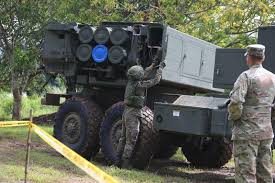Richard Sanders
In the escalating arms race across the Pacific, the United States and its allies are ramping up their military capabilities in a bid to counter China’s expanding influence and potential threats, particularly concerning Taiwan. As the geopolitical tension heightens, new missile systems are set to play a crucial role in regional security strategies.
Recently, the US successfully tested its latest precision strike missile (PrSM) in Australia, marking a significant advancement in missile technology. The missile, developed by Lockheed Martin, demonstrated its ability to strike targets over 190 miles away during the test. This marks the first deployment of the weapon by a US ally, showcasing its potential to inflict devastating losses on adversarial naval forces.
The PrSM can be launched from American-made HIMARS and British MLRS artillery systems — both of which have played key roles in recent conflicts, including Ukraine’s counter-offensives against Russian forces. While these launchers traditionally used Atacms missiles with a range of approximately 190 miles, the new PrSMs boast an extended range of over 300 miles, with future variants expected to push this boundary even further. During the Australia test, the missile reached speeds exceeding 4,000 km/h, surpassing the Atacms by about 300 km/h.
An indicator of the regional strategic shift, sources suggest that these missile systems will likely be deployed in the Philippines as part of ongoing training exercises conducted annually by the Philippines and its allies. These exercises aim to enhance interoperability and readiness in the face of China’s growing military presence in the region.
The future deployment of PrSMs in the Philippines will underscore the importance of regional alliances in maintaining stability and deterrence amid rising tensions. As Washington and its partners bolster their missile capabilities, the Philippines’s role as a key strategic partner is poised to increase further.
The US-led efforts to enhance missile technology and regional security continued to underline the fragile balance of power in the Pacific, with the fate of Taiwan remaining a critical concern for global geopolitics.
理查德·桑德斯
在越來越激烈的太平洋軍備競賽中, 美國及其盟友正加緊提升軍事能力,以應對中國不斷擴大的影響力及潛在威脅, 特別是與台灣有關的問題。 隨著地緣政治緊張局勢升高,新的導彈系統將在區域安全戰略中發揮關鍵作用。
最近,美國在澳大利亞成功測試了其最新的精準打擊導彈(PrSM),標誌著導彈技術的一重大進展。 這款由洛克希德·馬丁公司研發的導彈,在測試中展現了能夠擊中超過190英里的目標。 這也是美國盟友首次部署該武器,彰顯其對對手海軍力量造成毀滅性打擊的潛力。
PrSM可以從美國製造的HIMARS和英國MLRS火炮系統發射——這兩種系統在最近的衝突中發揮了關鍵作用,包括烏克蘭對俄軍的反攻。 雖然這些發射器傳統上使用範圍約為190英里的Atacms導彈,但新型的PrSM的射程已擴展超過300英里,未來的版本有望進一步推高這一數值。 在澳大利亞的測試中,導彈的速度超過了每小時4000公里,比Atacms快約300公里/小時。
這一動態也被視為區域戰略格局轉變的象徵,消息人士指出,這些導彈系統很可能會在菲律賓部署,作為菲律賓及其盟友每年舉行的聯合演習的一部分。 這些演習旨在提升協同作戰能力和作戰準備,以應對中國在該地區日益增強的軍事存在。
未來在菲律賓部署PrSM將突顯區域聯盟在維持穩定與威懾力方面的重要性,尤其是在緊張局勢升高的背景下。隨著華盛頓及其夥伴加強導彈能力,菲律賓作為一個關鍵戰略夥伴的角色預計將進一步提升。
由美國主導的提升導彈技術與區域安全的努力,持續強調太平洋地區力量的脆弱平衡,而台灣的命運依然是全球地緣政治中的重要關注點。



